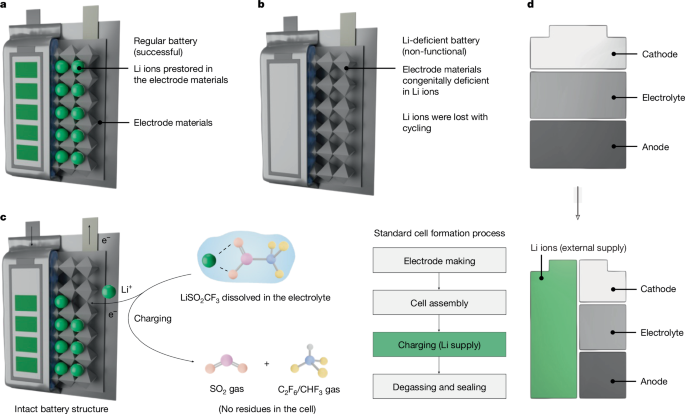Tarascon, J. M. & Armand, M. Issues and challenges facing rechargeable lithium batteries. Nature 414, 359–367 (2001).
Whittingham, M. S. Lithium batteries and cathode materials. Chem. Rev. 104, 4271–4301 (2004).
Fichtner, M. et al. Rechargeable batteries of the future—the state of the art from a BATTERY 2030+ perspective. Adv. Energy Mater. 12, 2102904 (2022).
Choi, J. W. & Aurbach, D. Promise and reality of post-lithium-ion batteries with high energy densities. Nat. Rev. Mater. 1, 16013 (2016).
Lin, D., Liu, Y. & Cui, Y. Reviving the lithium metal anode for high-energy batteries. Nat. Nanotech. 12, 194–206 (2017).
He, J. et al. Scalable production of high-performing woven lithium-ion fibre batteries. Nature 597, 57–63 (2021).
Dunn, B., Kamath, H. & Tarascon, J.-M. Electrical energy storage for the grid: a battery of choices. Science 334, 928–935 (2011).
Li, X. et al. Hydrogen isotope effects: a new path to high-energy aqueous rechargeable Li/Na-ion batteries. eScience 3, 100121 (2023).
Chen, H. et al. Free-standing ultrathin lithium metal–graphene oxide host foils with controllable thickness for lithium batteries. Nat. Energy 6, 790–798 (2021).
Zhao, J. et al. Artificial solid electrolyte interphase-protected LixSi nanoparticles: an efficient and stable prelithiation reagent for lithium-ion batteries. J. Am. Chem. Soc. 137, 8372–8375 (2015).
Bärmann, P. et al. Mechanistic insights into the pre-lithiation of silicon/graphite negative electrodes in “dry state” and after electrolyte addition using passivated lithium metal powder. Adv. Energy Mater. 11, 2100925 (2021).
Palanisamy, M., Parekh, M. H. & Pol, V. G. In situ replenishment of formation cycle lithium-ion loss for enhancing battery life. Adv. Funct. Mater. 30, 2003668 (2020).
Choi, J. et al. Weakly solvating solution enables chemical prelithiation of graphite-SiOx anodes for high-energy Li-ion batteries. J. Am. Chem. Soc. 143, 9169–9176 (2021).
Yang, C. et al. Roll-to-roll prelithiation of lithium-ion battery anodes by transfer printing. Nat. Energy 8, 703–713 (2023).
Wang, L. et al. Li-free cathode materials for high energy density lithium batteries. Joule 3, 2086–2102 (2019).
Hua, X. et al. Revisiting metal fluorides as lithium-ion battery cathodes. Nat. Mater. 20, 841–850 (2021).
Winter, M., Barnett, B. & Xu, K. Before Li ion batteries. Chem. Rev. 118, 11433–11456 (2018).
Poizot, P. et al. Opportunities and challenges for organic electrodes in electrochemical energy storage. Chem. Rev. 120, 6490–6557 (2020).
Lu, Y. & Chen, J. Prospects of organic electrode materials for practical lithium batteries. Nat. Rev. Chem. 4, 127–142 (2020).
Wang, J., Yang, J., Xie, J. & Xu, N. A novel conductive polymer-sulfur composite cathode material for rechargeable lithium batteries. Adv. Mater. 14, 963–965 (2002).
Kim, J. H. et al. Capacity fading mechanism of LiFePO4-based lithium secondary batteries for stationary energy storage. J. Power Sources 229, 190–197 (2013).
Cao, W., Li, J. & Wu, Z. Cycle-life and degradation mechanism of LiFePO4-based lithium-ion batteries at room and elevated temperatures. Ionics 22, 1791–1799 (2016).
Shanmukaraj, D. et al. Sacrificial salts: compensating the initial charge irreversibility in lithium batteries. Electrochem. Commun. 12, 1344–1347 (2010).
Jezowski, P. et al. Safe and recyclable lithium-ion capacitors using sacrificial organic lithium salt. Nat. Mater. 17, 167–173 (2018).
Sun, Y. et al. High-capacity battery cathode prelithiation to offset initial lithium loss. Nat. Energy 1, 15008 (2016).
Qiao, Y. et al. A high-energy-density and long-life initial-anode-free lithium battery enabled by a Li2O sacrificial agent. Nat. Energy 6, 653–662 (2021).
Jun, K. J. et al. Understanding the irreversible reaction pathway of the sacrificial cathode additive Li6CoO4. Adv. Energy Mater. 13, 2301132 (2023).
Meng, Q. et al. A functional prelithiation separator promises sustainable high-energy lithium-ion batteries. Adv. Energy Mater. 13, 2300507 (2023).
Dose, W. M. et al. Liquid ammonia chemical lithiation: an approach for high-energy and high-voltage Si-graphite|Li1+ xNi0.5Mn1.5O4 Li-ion batteries. ACS Appl. Energy Mater. 2, 5019–5028 (2019).
Wang, Z. et al. Unsupervised discovery of thin-film photovoltaic materials from unlabeled data. npj Comput. Mater. 7, 128 (2021).
Tao, K. et al. Rapid discovery of inorganic-organic solid composite electrolytes by unsupervised learning. Chem. Eng. J. 454, 140151 (2023).
Carter, H. A., Wang, Shiow-Chyn, C. & Shreeve, J. M. The Raman spectra of CF3SCF3, CF3S(O)CF3 and CF3SSCF3. Spectrochim. Acta A Mol. Spectrosc. 29, 1479–1491 (1973).
Wang, L. et al. Insights for understanding multiscale degradation of LiFePO4 cathodes. eScience 2, 125–137 (2022).
Haegyeom, K. & Jae, C. K. Opportunities and challenges in cathode development for non-lithium-ion batteries. eScience 4, 100232 (2024).
Aldo, G. et al. Unsupervised learning methods for molecular simulation data. Chem. Rev. 121, 9722–9758 (2021).
Zhang, Y. et al. Unsupervised discovery of solid-state lithium ion conductors. Nat. Commun. 10, 5260 (2019).
Li, K. et al. Machine learning-guided discovery of ionic polymer electrolytes for lithium metal batteries. Nat. Commun. 14, 2789 (2023).
Merrick, J. P., Moran, D. & Radom, L. An evaluation of harmonic vibrational frequency scale factors. J. Phys. Chem. A 111, 11683–11700 (2007).
Goerigk, L. & Grimme, S. A thorough benchmark of density functional methods for general main group thermochemistry, kinetics, and noncovalent interactions. Phys. Chem. Chem. Phys. 13, 6670–6688 (2011).
Holoubek, J. et al. Tailoring electrolyte solvation for Li metal batteries cycled at ultra-low temperature. Nat. Energy 6, 303–313 (2021).
Lu, C. et al. High-performance fibre battery with polymer gel electrolyte. Nature 629, 86–91 (2024).


